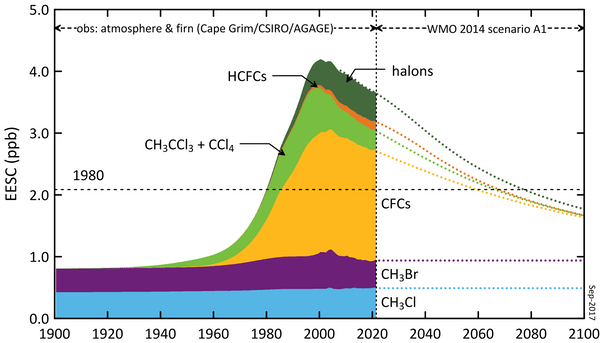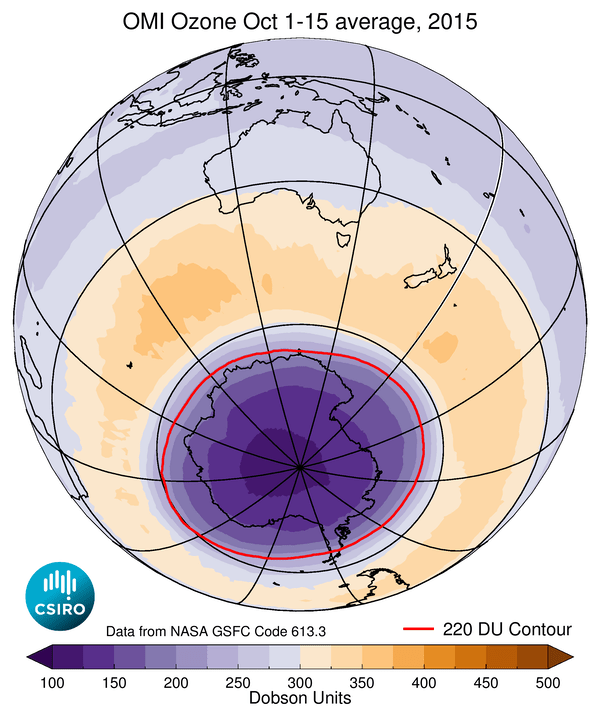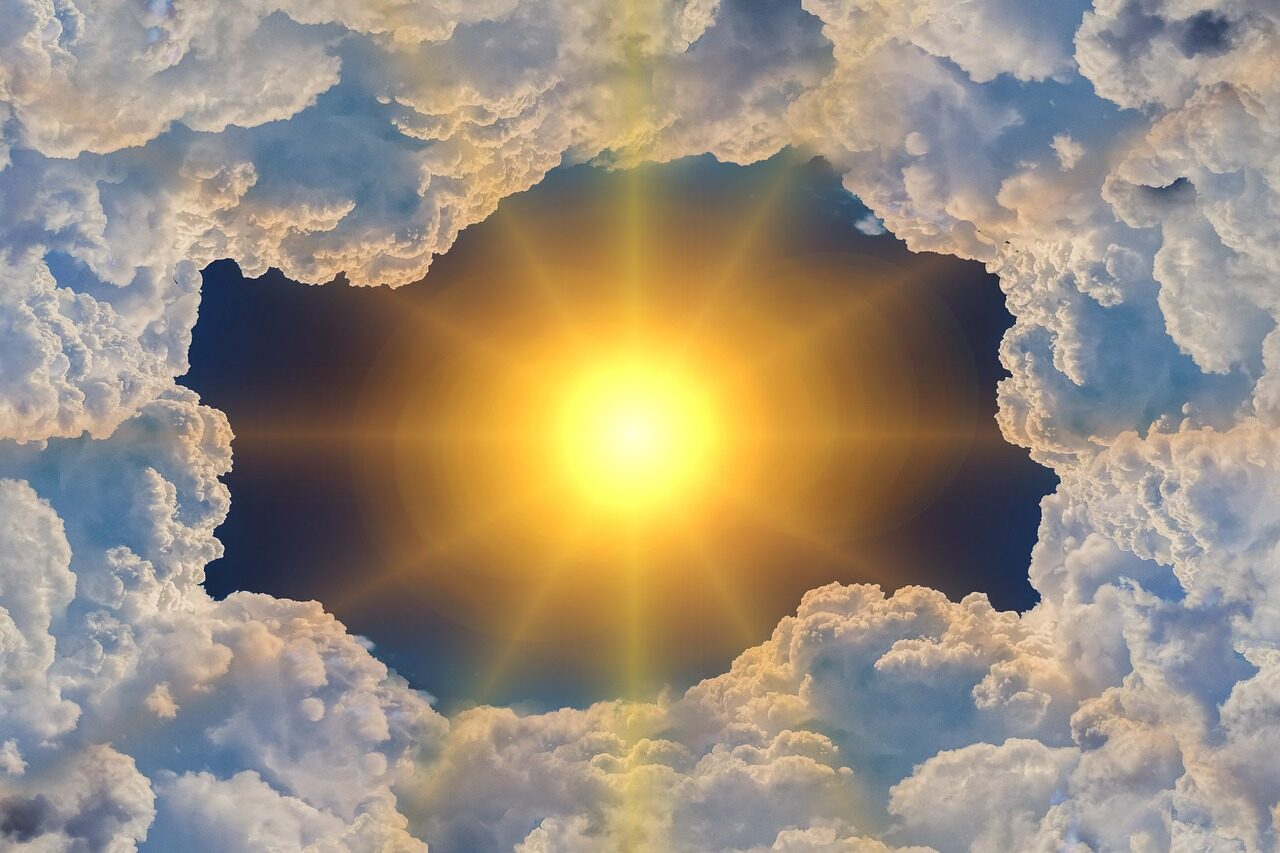The research argues that extremely low winter temperatures high in the atmosphere over the Arctic are becoming more frequent and more extreme because of climate patterns associated with global warming.
In a perfect example of what George Orwell called Doublethink the AGW party is claiming that global 'warming' can also mean global 'cooling' — i.e. that your CO2 emissions (i.e. your existence) are responsible for ALL things climate; even the stark cooling we've witnessed since 2016.
The paper goes on, stating that these extreme low temperatures are said to be causing reactions with the remaining ozone depleting chemicals and leading to greater ozone losses.
The new study by UMD, the Alfred Wegener Institute's Helmholtz Centre for Polar and Marine Research, and the Finnish Meteorological Institute has been published in the journal Nature Communications.
Ross Salawitch, professor in the UMD Department of Atmospheric and Oceanic Science, the Department of Chemistry and Biochemistry, and the Earth System Science Interdisciplinary Center, said:
"We're in a kind of race between the slow and steady decline in CFCs, which take 50 to 100 years to go away, and climate change, which is causing polar vortex temperature extremes to become colder at a rapid pace.New data from the study showed the coldest Arctic polar vortex temperatures and the highest ozone losses on record in 2020, beating the previous records set nine years ago in 2011 (some sort of solar minimum correlation is highly likely here-not that the researches dare touch the possibility that a natural phenomenon could be behind their findings).
"The increasingly cold temperatures, Salawitch continues, "create conditions that promote ozone depletion by CFCs. So, even though these compounds are slowly going away, Arctic ozone depletion is on the rise as the climate changes."
Comment: It is not just highly likely, but the sun is the main factor that influences the climate on earth and all other planets in the solar system.
According to these scientists, the chlorine is normally non-reactive within the Arctic polar vortex but clouds provide the right conditions for the chlorine to change form and react with bromine and sunlight to destroy ozone.
The story is similar above the Antarctic, too.
The European Union's Earth observation program announced at the end of 2020 that the ozone hole over Antarctica had swelled to its largest size and deepest level in at least 15 years, to become among the most notable ever recorded.
Clare Nullis, of the warm-mongering WMO, explains that the ozone hole begins to expand every August -at the start of the Antarctic spring- and reaches a peak around October.
"The air has been below minus 78 degrees Celsius, and this is the temperature which you need to form stratospheric clouds — and this is quite a complex process," said Nullis at a U.N. briefing in October, 2020.But these findings contradict the absurd consensus that global warming is causing the global cooling, and again they go against the so-called 'science' behind the international accord (the Montreal Protocol) devised to phase out those ozone-depleting substances (OSDs)-such as CFC and HCFC refrigerants .
"The ice in these clouds triggers a reaction which then can destroy the ozone. So, it's because of that that we are seeing the big ozone hole this year."
OSDs have been on the decline since their peak in 2000 (shown below), and the holes growing above the poles a full 2+ decades later shows the correlation between OSDs and ozone isn't there. It simply doesn't play that reduced OSDs are all of a sudden having an unprecedented impact on the ozone layer. No, the mechanism here appears to be natural, and likely associated in some way with the historically low solar activity Earth has been receiving over the past decade+.

Comment: At the same time the earth's rotation and the rotations of other planets in our solar system are slowing down. That is the cause of the increased seismic activity and the planet heating up from inside.
If we want to solve the puzzle about climate change on earth and on other planets in our solar system we must answer few crucial questions.
What is slowing down the rotation of the planets in our solar system?
Why is sun activity so weak and why is the meteors and comets activity increased in the last decade or so?
Is all this related and could it be a natural cycle, and not a man-made "climate change"?
The formation of stratospheric ozone is initiated by ultraviolet (UV) radiation coming from the Sun.
As a result, an increase in the Sun's radiation output increases the amount of ozone in Earth's atmosphere.
The Sun's radiation output and sunspot number vary over the well-documented 11-year solar cycle. Observations over several solar cycles since the 1960s show that global total ozone levels vary by 1 to 2% between the maximum and minimum of a typical cycle.
However, 'global' total ozone levels aren't necessarily what we're interested in here. Evidence suggests that ozone depletion during times of low solar activity is far greater above the poles than elsewhere on the planet. This is a phenomenon we're seeing today, at both the Antarctic and Arctic.
This could well be the true cause of Polar Amplification.
Climate alarmists of course love to claim that CO2 is disproportionately warming the Arctic, but they have no agreed-upon mechanism as to how this could occur.
It is fantasy.
On the other hand, a positive correlation between decreasing solar activity and ozone depletion above the Arctic fits very well, as does the negative correlation between ozone depletion and rising surface temps.
There is another key forcing to factor into all this, and that is volcanic eruptions.
Explosive volcanic eruptions inject sulfur gases directly into the stratosphere, causing new sulfate particles to be formed. The particles initially form in the stratosphere downwind of the volcano and then spread throughout the hemisphere or globally as air is transported by stratospheric winds.
One method of detecting the presence of volcanic particles in the stratosphere uses observations of the transmission of solar radiation through the atmosphere. When large amounts of new particles are formed in the stratosphere over an extensive region, solar transmission is measurably reduced (as are terrestrial temperatures).
The eruptions of Mt. Agung (1963), El Chichón (1982), and Mt. Pinatubo (1991) are the most recent sizable examples of sulfur injections that temporarily reduced solar transmission. Chile's Calbuco volcanic eruption (2015) is another- this stratospheric injection played a role in enhancing the size of the ozone hole back in 2015:

2020's hole appears even larger that 2015's, clear indication that factors other than ODSs are key to ozone depletion above the poles — namely, surprise-surprise, solar and volcanic activity.
Unfortunately, the U.N. and its fraudulent little offshoot -the WMO- remains chained to the Montreal Protocol.
Clare Nullis concludes that despite these expanding holes, experts still believe the ozone layer is slowly recovering after adoption of the accord in 1987, and she urges nations to stick to the measures, citing climate projections that indicate that the ozone layer will return to 1980 levels in 2060.
They must think we're idiots; but I worry, as a collective, that we are.
"If you want a picture of the future, imagine a boot stamping on a human face — forever."
― George Orwell, 1984




Comment: See also: